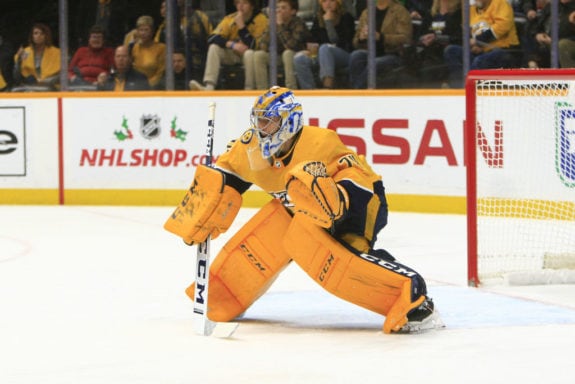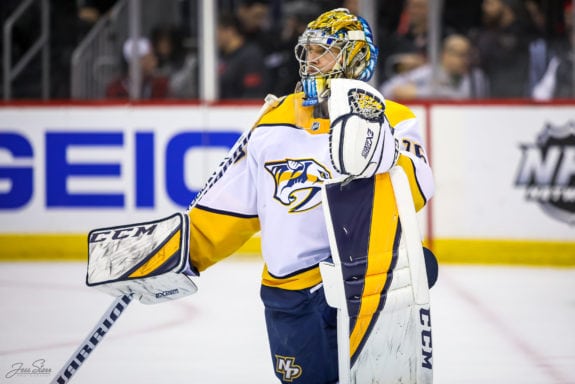At first glance, it may seem like the Nashville Predators have a logjam in the crease. With former Vezina Trophy winner Pekka Rinne and current presumed starter Juuse Saros manning the net on the 2020-21 depth chart, one might think the Predators are faced with a controversy. However, this is not quite the case as the starting job appears to belong to Saros following his performance down the stretch and into the playoffs last season.
Related: Predators’ 3 Best & Worst Trades All-Time
Both Rinne and Saros are set to be free agents after this coming season; Rinne will likely hit the open market as an unrestricted free agent, while Saros will become a restricted free agent should an extension not be agreed upon in the next few months. This presents an interesting dilemma for Nashville, as in the short-term, and as you’ll read here, keeping both of them at least for this season could be very productive. As Samantha Sgro explains, the long-term future in goal may have been selected in the recent Entry Draft.
We’ve seen plenty of teams go deep with two solid goalies, either in a platoon situation or with a stellar experienced backup as a mentor the younger starter can lean on. With no other goalie in the organization having any NHL experience, short of signing a remaining free agent and trading Rinne, keeping the veteran as a backup or a 1B goalie is the best option as we approach the 2020-21 season.
Juuse Saros as the Starter
Saros impressed down the stretch for the Predators, going 12-5-1 in his final 18 starts. He played well in the playoffs despite the Predators losing in four to the Arizona Coyotes in the best-of-five qualifying series. While his .895 save percentage doesn’t leap off the page, while facing an average of 31 shots in the four games he’s hardly at fault for the Predators’ rapid playoff exit. In 17 of his last 25 appearances, including playoffs, Saros faced at least 30 shots, winning 10 and earning three shutouts in those games.

The fact that Saros played every minute in goal in the playoff bubble could speak volumes to how head coach John Hynes is going to approach his goalie situation this coming season, and certainly Saros’s performance in the regular season once Hynes took over as coach could indicate Saros is the guy in the crease.
Saros is still young at 25 and could play himself into a long-term contract with the Predators. He’s shown he can perform at a high level with a career .918 save percentage. The athletic Finn is likely the short-term future in the crease and appears ready to be an NHL starter.
Pekka Rinne as the Backup
While it is still realistic that general manager David Poile trades Rinne at the trade deadline (Rinne would have to approve 10 teams to his no-trade clause), that may largely depend on where Nashville sits in the standings at the time. If the Predators are in the thick of a playoff race, keeping Rinne’s experience for a potential run would be a huge benefit. Should the playoffs appear out of reach come the deadline, moving Rinne could be more of a possibility in order to acquire some assets for the future.
Some might argue that Rinne’s $5 million cap hit is too much for a backup goaltender, but if Rinne does enter the season as the Predators’ backup, he would not be the most expensive backup in the NHL. Marc-Andre Fleury is slated to enter the 2020-21 season as the fourth highest-paid goaltender in the league and serve as Vegas’s backup. Nashville is on track to have the 18th-highest cap hit by goaltenders with Saros and Rinne combining for only $6.5 million. Compare that to the $12 million cap hit by Vegas’s goalies, or the whopping $14.85 million cap hit by Montreal’s goalies, and the $5 million committed to Rinne does not seem so pricey.

There is also a great deal of sentimentality within the fanbase and organization for Rinne; selected by Nashville in the eighth round of the 2004 Entry Draft, Rinne has played more NHL games than any other eighth-round goalie in league history. He’s the franchise leader in most goalie categories, and is third among active goalies in 30-win seasons with eight. Take into consideration the total lack of NHL experience among the other goaltenders in the organization, and it seems highly unlikely, given that the Predators aren’t in a “rebuild,” would jettison Rinne without getting some kind of goaltending experience in return.
What Does the Future Hold?
Rinne and Saros are the only two goalies to see any action for the Predators since the start of the 2017-18 season, and coach Hynes has said on record “They’ve always supported each other. They always have each other’s back.” This type of relationship, especially one between a veteran and a younger goalie, is valuable and tough to find or foster.
While the Predators wait for Iaroslav Askarov to be pro-ready, it’s entirely feasible to sign another veteran goalie as a placeholder backing up Saros. Some veteran backup-calibre goalies who are slated to hit the UFA market next off-season (under the age of 30) include David Rittich, Laurent Brossoit, Charlie Lindgren. Given the placeholder nature of the position, it’s also possible to see the Predators chase an older free agent like James Reimer, Petr Mrazek, or Anders Nilsson.
The wild-card situation is the Predators re-sign Rinne to a less expensive, short-term deal to help bridge the gap and allow him to finish his career in Nashville. Whatever the Predators decide to do with Rinne, having him in the lineup for the upcoming season is the logical thing to do for the short-term success of the team. If Saros falters early, it’s an easy turn to Rinne to man the net without being a drastic step back in terms of talent.